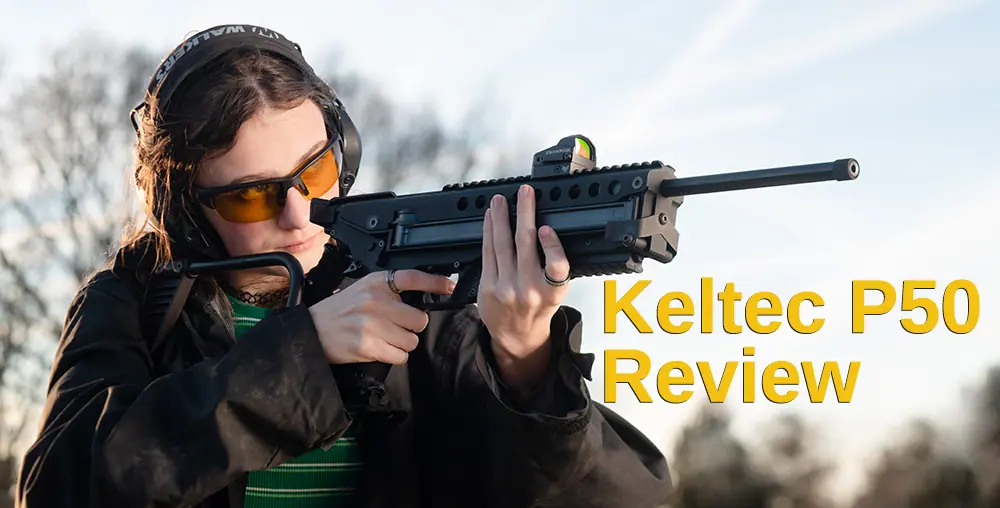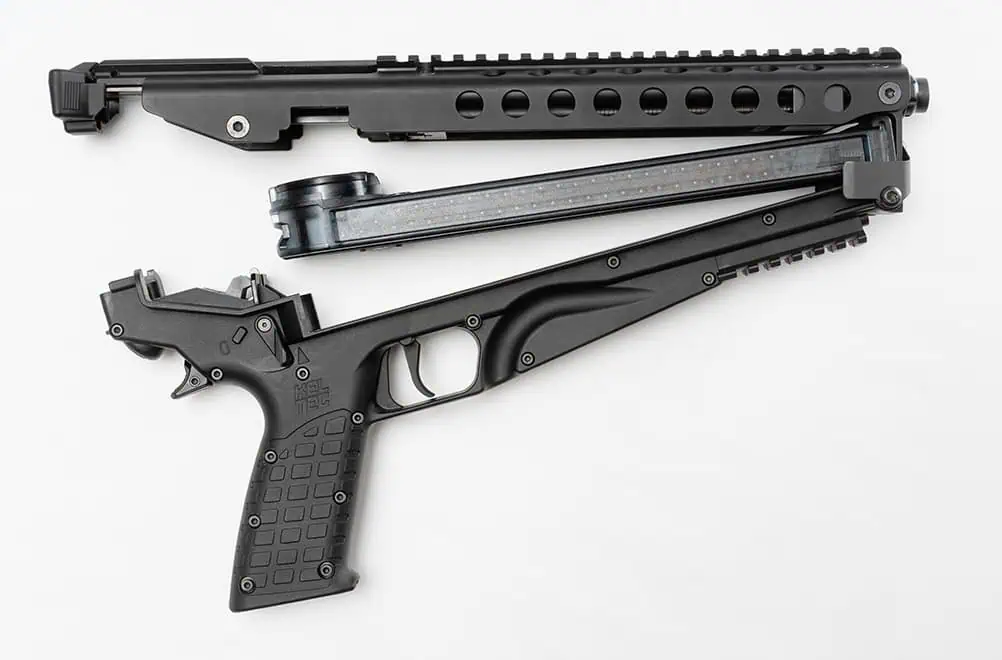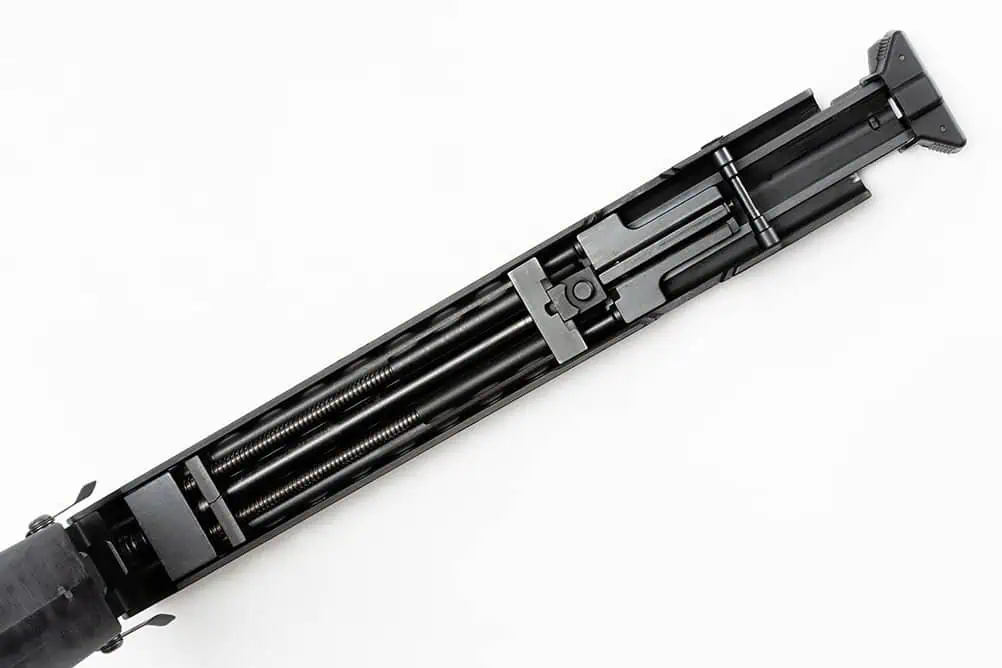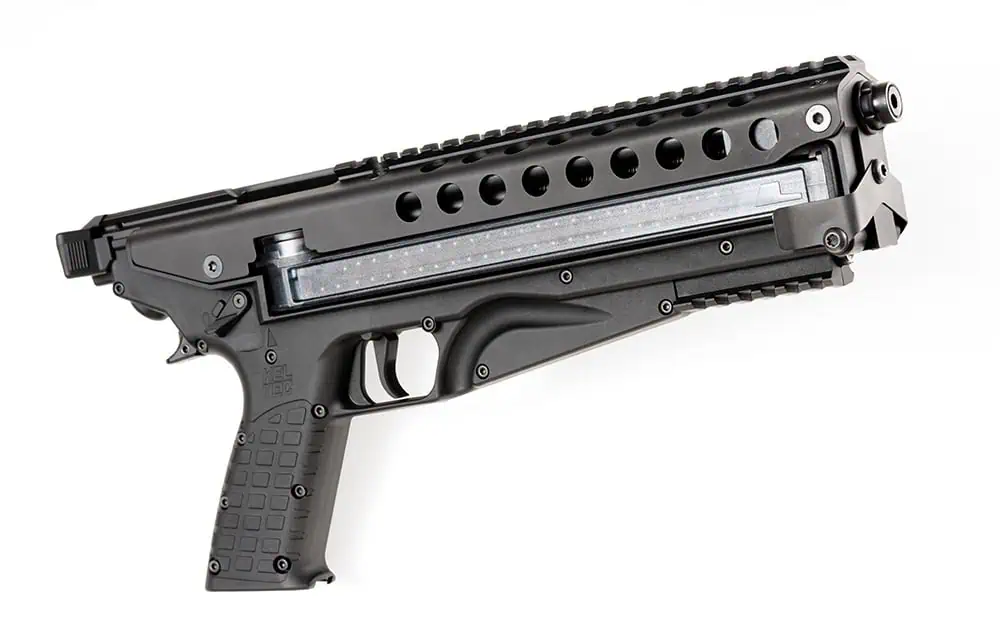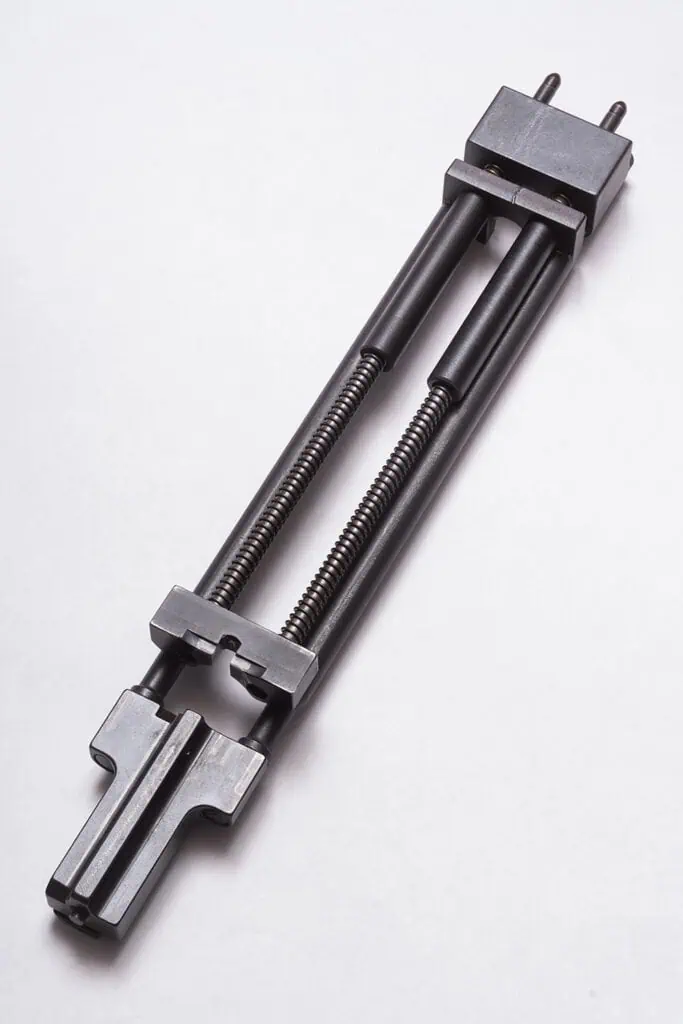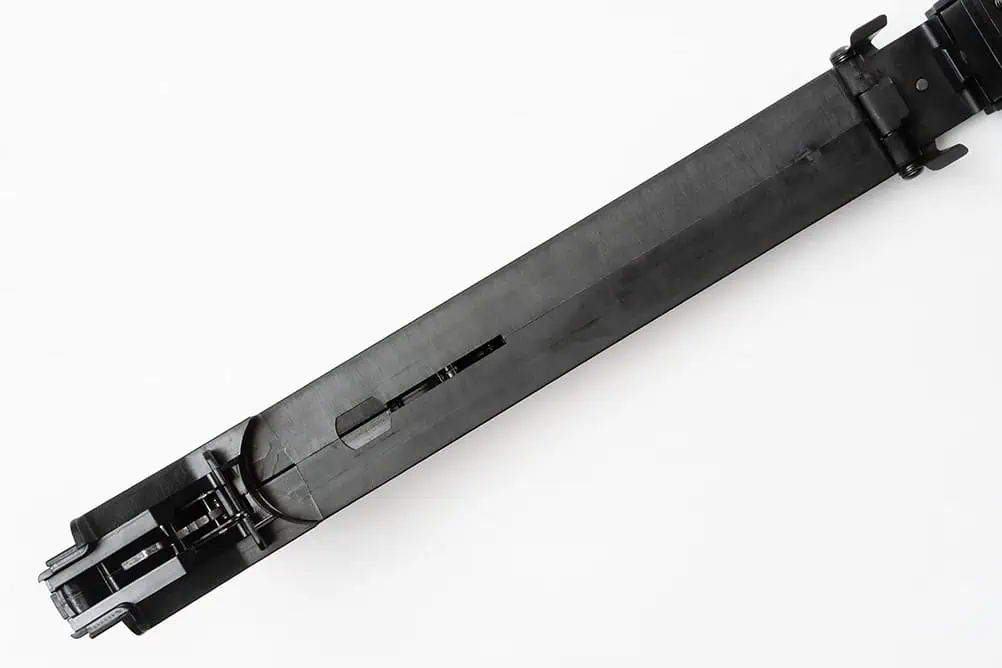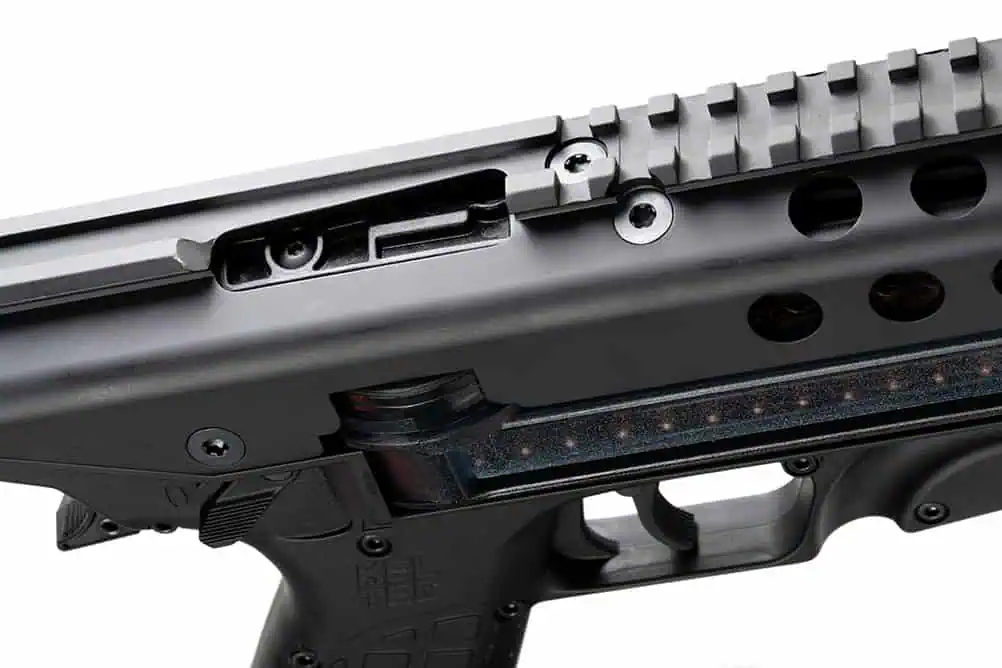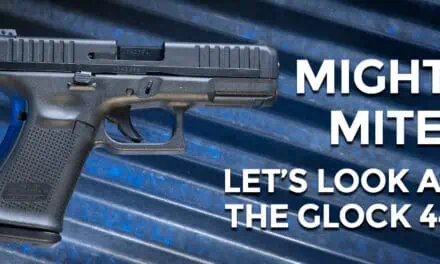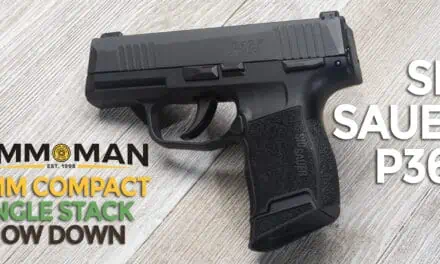Keltec’s P50 offers massive capacity at 50 rounds and virtually no recoil in a firearm that’s a bit of a hybrid between a rifle and pistol. Let’s dive into the details and review this space-gun!
What We Like About the Keltec P50
- Massive capacity of 50 rounds
- Lightweight and virtually recoil free; a treat to shoot
What We Don’t Like About the P50
- Somewhat awkward reloading process. It’s tedious and unorthodox to efficiently fire multiple magazines.
How Keltec Got Here with the P50
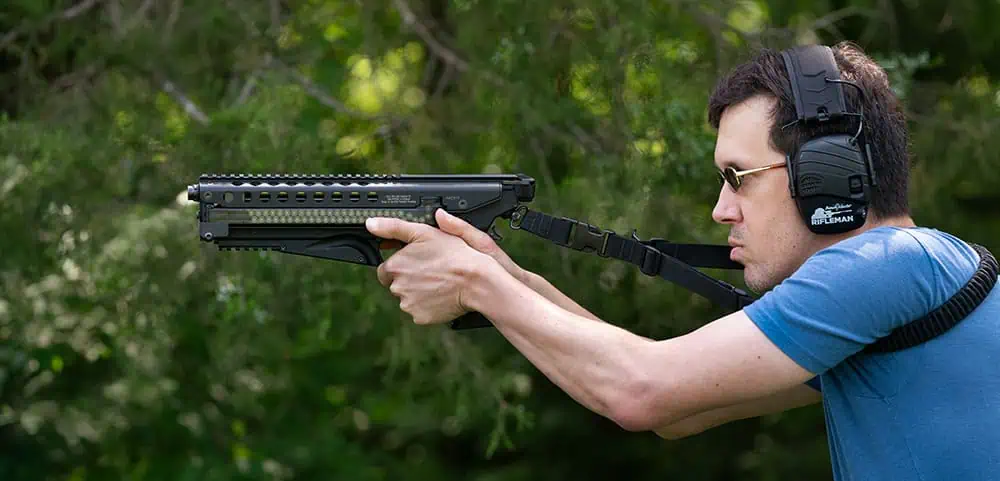
Oleg, the author of this review, shooting the P50 at the range.
Kel-tec’s entry in the PDW field started with a 5.7×28 drone gun. A straight blowback firearm with the dual-spring recoil assembly strongly resembling the M3 “grease gun”, it had little kick and offered excellent reliability. Adding a pistol, submachine gun, or carbine lower to it gave a very light-weight and fairly accurate hand-held firearm.
Loading it remained odd: top cover lifted for magazine swaps in a manner similar to a belt-fed machine gun. With magazines requiring swapping only once every 50 rounds, this slower reload may be good enough for non-military use — after all, how many self-defense fights over the past decades have gone over that many shots from one defender?
P50 Variants Available
Three models are available commercially: a 3.2lb P50 handgun with a 9.6″ barrel, R50 carbine with a 16″ barrel and a strut stock folding to either side of the receiver. It’s a tax stamp away from becoming R50 Defender SBR with the rifle’s stock and the pistol’s shorter barrel.
All three are very accurate, all sound-suppressible, all lightly recoiling. Keltec threaded the barrels 1/2×28 for a flash hider or sound suppressor.
They come with knurled muzzle thread protectors. Kel-tec’s rifle variant weighs only 4.3 pounds. That’s two whopping pounds less than FN’s PS90, and comes with a superior trigger. The ambidextrous safety lever blocks the sear and disengages the trigger, resulting in a floppy trigger. P50 trigger breaks at 5 pounds, feeling like a very light revolver double action.
| Caliber | 5.7x28mm |
|---|---|
| Weight Unloaded | 3.2 pounds |
| Magazine Capacity | 50 Rounds |
| Overall Length | 15" |
| Barrel Length | 9.6" |
| Barrel Threads | 1/2-28 TPI |
| Height | 6.7" |
| Width | 2" |
| Trigger Pull | 5 pounds |
| Grips | Polymer |
| MSRP | $795 |
Handing and Shooting the P50
While not quite a bullpup, the P50 boasts a barrel that’s almost 2/3 of its overall length.
Being extremely lightweight, with the ammunition distributed evenly over most of its length, P50 doesn’t feel front heavy and can be grasped with one or two hands like a conventional pistol. There’s no perceptible shift in balance as the ammunition in the magazine is depleted. For better recoil control, using a sling inserted into the back QD socket and support hand on the dust cover works even better. Ejection is mostly up and slightly forwards, making it equally safe for left-handed shooters. All controls — safety, action release, charging handle — are ambidextrous.
Unmatched Capacity
P50 outclasses other pistols with 50-shot capacity provided by P90 magazines. Although chambered in the relatively energetic 5.7x28mm, P50 recoils like a 22 rimfire pistol.
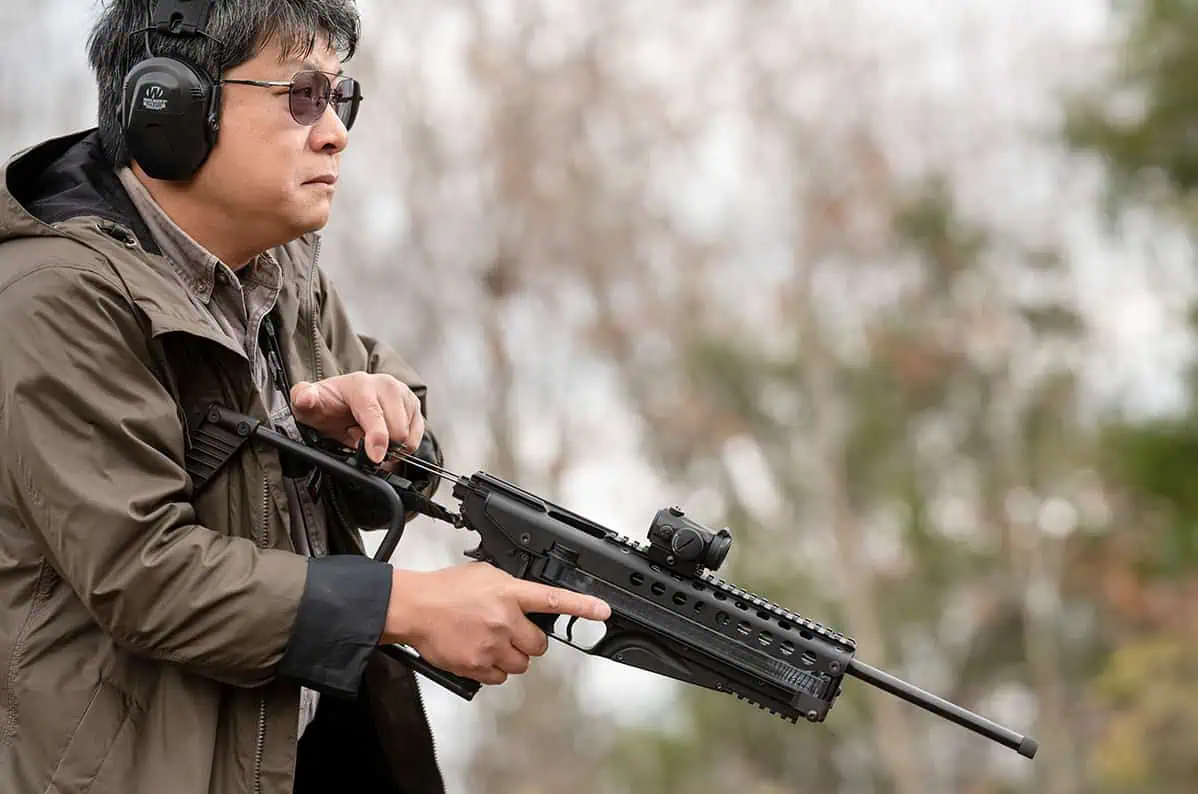
The manual of arms is slightly unorthodox. Since there’s no last shot bolt hold-open, it’s likely that the last trigger pull would drop the hammer. Run the charging handle to cock the action after the last shot: while the action can be opened with the hammer down, it won’t close that way. Then, press the action release lever located above the web of the strong hand to pop over the ventilated steel top cover to pull out or shake out the empty magazine, place a full one in its place with the ammunition facing up — not down like on the P90 — and close the cover. Run the AR15 style charging handle once to chamber the first round.
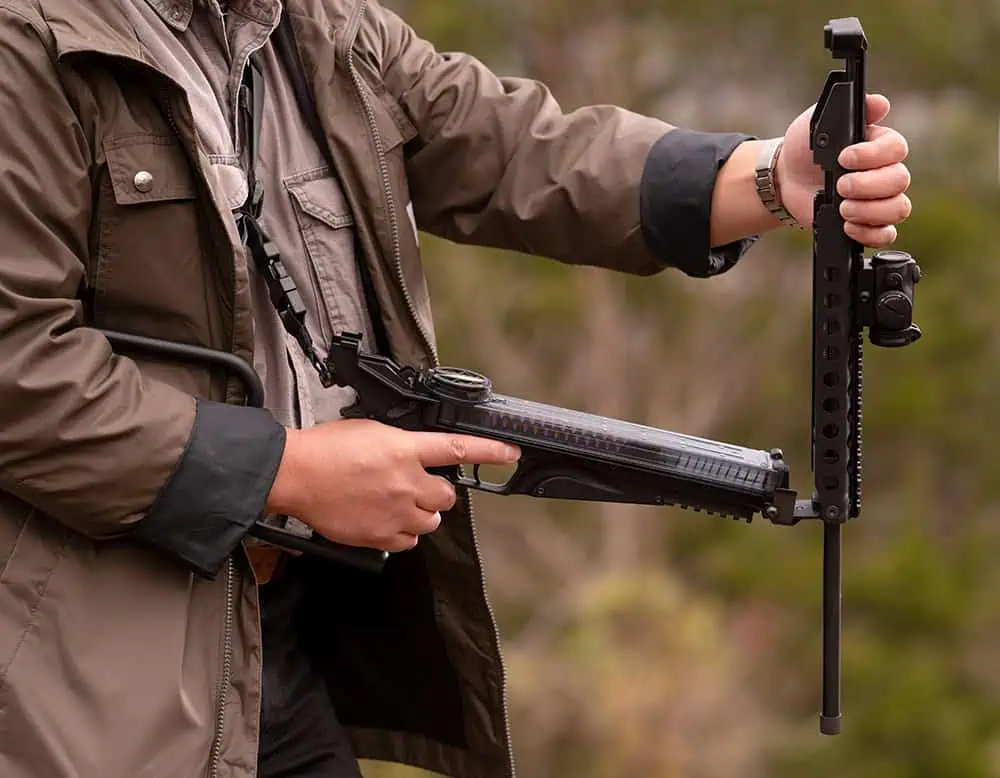
The manual of arms comes from the premium placed on highly dust-sealed internals. Reloading has to be done one-third as often as with a typical service pistol, so there’s no time lost overall. The pistol ships with two 50-round magazines, enough for any real-world defensive fight.
Disassembly is extremely simple. Open the top cover. With a cartridge tip, pull the recoil block forward and away from the receiver as a single unit. The charging handle comes out of the back and the field-stripping is complete, with full access to the chamber. Reassembly is in reverse order, taking only a few seconds.
Why Opt for the 5.7×28 Caliber?
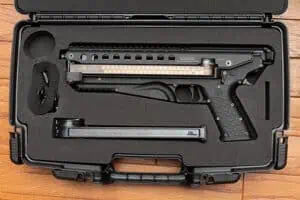 When FN introduced the 5.7×28 PDW cartridge a third of a century ago, some viewed it as the magic bullet. Its combat debut during the 1997 raid to extract hostages from the Japanese embassy in Peru confirmed effectiveness in confined space against armored opponents in the presence of noncombatants. Since then, more than 40 countries have adopted P90 for military and police use.
When FN introduced the 5.7×28 PDW cartridge a third of a century ago, some viewed it as the magic bullet. Its combat debut during the 1997 raid to extract hostages from the Japanese embassy in Peru confirmed effectiveness in confined space against armored opponents in the presence of noncombatants. Since then, more than 40 countries have adopted P90 for military and police use.
In the US, very few police departments that adopted 5.7×28 arms kept them. Typical US adversaries don’t wear armor and some shooters find the terminal performance of the ammunition lacking.
By contrast, the Federal agencies that adopted P90s generally kept them. In private hands, the adoption was limited by the high prices of the FN firearms chambering them. National Firearms Act rules limiting short-barreled automatic rifles like P90 didn’t help either.
There was also a perception that good ammunition — specifically the armor-piercing variety around which 5.7×28 was originally created — was largely unavailable to the public. “It’s just a glorified 22 Magnum for more money” was the oft-heard disparagement.
Civilian Popularity Increase
Over the past several years, popularity of this cartridge took off spectacularly, with a dozen or more companies making handguns and rifles in that caliber. The theory that 5.7×28 can be replaced by 22 WMR proved inaccurate: the FN round chamber pressure is 57,000 psi, while the rimfire cartridge operates at 24,000 psi. As a result, 5.7 generates high velocity numbers even with pistol length barrels. On the other side, you have to fire 22 WMR from a rifle to get close. Close, as in 1800-1900fps vs 2100-2300 feet per second for 40 grain bullets from a 16″ rifles.
While 22 WMR cases are slimmer than the bottlenecked 5.7, rimless centerfire cartridges fit box and more complex magazines, like P90, better. The cartridges themselves are more robust and stand up better to rough handling. In the end, less expensive and more accurate 22WMR found its nice in varmint hunting, while more energetic 5.7 became one of the popular rounds for defensive arms.
Velocity from the Keltec P50
Velocity difference between pistol and carbine variants isn’t drastic: Fiocchi Hyperformance tipped hollow point runs 1960 feet per second from P50 (9.6″ barrel) and 2100 feet per second from R50 (16″).
Lead-free 27 grain practice FN SS195LF reaches 2300 feet per second from 9.6″ pistol, just under 2500 feet per second from 16″ rifle.
American Eagle 40gr FMJ yielded 1920 feet per second and 2020 feet per second respectively.
Trajectory Considerations
The choice of ammunition depends mainly on the terminal performance desired. All three bullets yaw very rapidly, with SS195LF doing it inside of 2 inches, AE and Fiocchi bullets at around 3 inches of penetration. Fired from the 9.6″ pistol, we found the 27 grain bullet went about 8 inches into Clear Ballistics gel. The 40 grain TMJ made it 19 inches in!
Gel Performance
The hollow point split the difference, with the lead core expanded to .32 caliber and the copper jacket found separately from each other at the 10 inch mark. It created the greatest disruption in the gel, but all three showed substantial yaw marks out to about 6-7 inches. This is on the light side for human foes, plenty adequate for a dog or a coyote. However, the doctrine behind PDW is “anyone worth shooting, is worth shooting more than once”, and 5.7’s low recoil makes for quick follow-up shots.
Sights & Accuracy
P50 comes with post and notch iron sights recessed within the Picatinny rail:13 inches of sight radius with elevation adjustment on the front and windage adjustment on the back allow a good degree of precision.
Standing, I could keep hit consistently on a silhouette target out to 35 yards. Using a red dot sight, slow-fire accuracy with the two 40-grain loads was excellent at 2 MOA. I attribute this to the fixed barrel and good trigger. The lighter 27 grain practice lead-free bullets grouped around 3 MOA. With a red dot, the pistol was accurate enough for uprooted fire to 100 yards. Supported, you can take it to nearly 200.
While plenty good for practice and defense, the spread limits its use for longer-distance varmint shots, as does the rapid loss of velocity due to low density. The fragile construction makes it quite good for shooting steel targets up close with minimized ricochet or splatter risk. The higher 27 grain practice lead-free bullets grouped around 3 MOA. While plenty good for practice and defense, the spread limits its use for longer-distance varmint shots, as does the rapid loss of velocity due to low density. The fragile construction makes it quite good for shooting steel targets up close with minimized ricochet or splatter risk.
While 5.7 can be flashy from shorter barrels, 9.6″ produces only a small flame, while 16″ makes almost none. The bullet flight noise cannot be silenced, but most steel .22 sound suppressors are robust enough to tame the report. All in all, P50 or R50 with either AE or the Fiocchi cartridges can do a good job of discouraging evil to the last drop of its precious bodily fluids. The lead-free round is best left for practice or short-range varmints.
The Keltec P50 In Summary
Good accuracy, low recoil, effective range past 150 yards, higher hit probability higher than with a conventional pistol, able to defeat soft body armor: P50 has everything needed to get popular at shooting ranges and on Hollywood movie sets. And it’s just plain fun to shoot!

